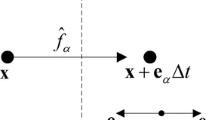Abstract
A discrete kinetic nine-velocity model of the Boltzmann equation on a plane is considered. In the limit of small free path and low bulk velocities, this model describes flows of viscous incompressible fluids. The complete discretization of the model over the time and spatial variables, which is, in particular, required for the numerical solution, is carried out using the truncated Wild sum. It is shown that the scheme has the second order of accuracy. As an example of the application of the proposed method, numerical solutions of two benchmark problems are obtained—Taylor–Green vortices and flow in a cavity with a moving boundary. The simulation results are compared with the solutions obtained on the basis of the classical nine-velocity lattice Boltzmann model.






Similar content being viewed by others
REFERENCES
T. Krüger, H. Kusumaatmaja, A. Kuzmin, O. Shardt, G. Silva, and E. Viggen, The Lattice Boltzmann Method. Principles and Practice (Springer, Swizerland, 2017).
M. Kogan, Rarefied Gas Dynamics (Plenum, New York, 1969).
L. Broadwell, “Shock structure in a simple discrete velocity gas,” Phys. Fluids 7, 1243–1247 (1964).
S. Godunov and U. Sultangazin, “On discrete models of the kinetic Boltzmann equation,” Russ. Math. Surveys 26, 1–56 (1971).
R. Gatignol, “The hydrodynamical description for a discrete velocity model of gas,” Complex Syst. 1, 709–725 (1987).
A. Wagner, “An H-theorem for the lattice Boltzmann approach to hydrodynamics,” Europhys. Lett. 44, 144–149 (1998).
W.-A. Yong and L.-S. Luo, “Nonexistence of H-theorems for the athermal lattice Boltzmann models with polynomial equilibria,” Phys. Rev. E 67, 051105 (2003).
W.-A. Yong and L.-S. Luo, “Nonexistence of H-theorem for some lattice Boltzmann models,” J. Stat. Phys. 121, 91–103 (2005).
I. Karlin, A. Ferrante, and H. Öttinger, “Perfect entropy functions of the lattice Boltzmann method,” Europhys. Lett. 47, 182–188 (1999).
S. Ansumali, I. Karlin, and H. Öttinger, “Minimal entropic kinetic models for hydrodynamics,” Europhys. Lett. 63, 798–804 (2003).
I. Karlin, S. Ansumali, C. Frouzakis, and S. Chikatamarla, “Elements of the lattice Boltzmann method I: Linear advection equation,” Commun. Comput. Phys. 1, 616–655 (2006).
I. Karlin, S. Chikatamarla, and S. Ansumali, “Elements of the lattice Boltzmann method II: Kinetics and hydrodynamics in one dimension,” Commun. Comput. Phys. 2, 196–238 (2007).
H. Chen, I. Goldhirsch, and S. Orszag, “Discrete rotational symmetry, moment isotropy, and higher order lattice Boltzmann models,” J. Sci. Comput. 34, 87–112 (2008).
A. Bobylev and G. Spiga, “On a class of exact two-dimensional stationary solutions for the Broadwell model of the Boltzmann equation,” J. Phys. A: Math. Gen. 27, 7451–7459 (1994).
A. Bobylev, “Exact solutions of discrete kinetic models and stationary problems for the plane Broadwell model,” Math. Methods Appl. Sci. 19, 825–845 (1996).
A. Bobylev and G. Toscani, “Two dimensional half-space problems for the Broadwell discrete velocity model,” Contin. Mech. Thermodyn. 8, 257–274 (1996).
A. Bobylev, G. Caraffini, and G. Spiga, “Non-stationary two-dimensional potential flows by the Broadwell model equations,” Eur. J. Mech. B Fluids 19, 303–315 (2000).
O. Ilyin, “The analytical solutions of 2D stationary Broadwell kinetic model,” J. Stat. Phys. 146, 67–72 (2012).
O. Ilyin, “Symmetries, streamline function, and exact solutions of the two-dimensional stationary kinetic Broadwell model,” Teor. Mat. Fiz. 179, 350–359 (2014).
K. Uchiyama, “On the Boltzmann–Grad limit for the Broadwell model of the Boltzmann equation,” J. Stat. Phys. 52, 331–355 (1988).
H. Babovsky, “‘Small’ kinetic models for transitional flow simulations,” AIP Conf. Proc. 1501, 272–278 (2012).
H. Babovsky, “Discrete kinetic models in the fluid dynamic limit,” Comput. Math. Appl. 67, 256–271 (2014).
O. Ilyin, “Discrete velocity Boltzmann model for quasi-incompressible hydrodynamics,” Mathematics 9, 993 (2021).
E. Wild, “On Boltzmann’s equation in the kinetic theory of gases,” Proc. Camb. Philos. Soc. 47, 602–609 (1951).
H. McKean, “An exponential formula for solving Boltzmann’s equation for a Maxwellian gas,” J. Combinat. Theory 2, 358–382 (1967).
E. Gabetta, L. Pareschi, and G. Toscani, “Wild’s sums and numerical approximation of nonlinear kinetic equations,” Transp. Theory Stat. Phys. 25, 515–530 (1996).
E. Gabetta, L. Pareschi, and G. Toscani, “Relaxation schemes for nonlinear kinetic equations,” SIAM J. Numer. Anal. 34, 2168–2194 (1997).
J. Latt, Hydrodynamic Limit of Lattice Boltzmann Equations, Dissertation, Geneva: University of Geneva, 2007.
P. Chauvat and R. Gatignol, “Euler and Navier–Stokes description for a class of discrete models of gases with different moduli,” Transp. Theory Stat. Phys. 21, 417–435 (1992).
U. Ghia, K. Ghia, and C. Shin, “High-Re solutions for incompressible flow using the Navier–Stokes equations and a multigrid method,” J. Comp. Phys. 48, 387–411 (1982).
A. Montessori, G. Falcucci, P. Prestininzi, M. La Rocca, and S. Succi, “Regularized lattice Bhatnagar–Gross–Krook model for two- and three-dimensional cavity flow simulations,” Phys. Rev. E 89, 053317 (2014).
J.-S. Wu and Y.-L. Shao, “Simulation of lid-driven cavity flows by parallel lattice Boltzmann method using multi-relaxation-time scheme,” Int. J. Numer. Meth. Fluids. 46, 921–937 (2004).
J. Latt and B. Chopard, “Lattice Boltzmann method with regularized pre-collision distribution functions,” Math. Comput. Simul. 72, 165–168 (2006).
J. Sterling and S. Chen, “Stability analysis of lattice Boltzmann methods,” J. Comp. Phys. 123, 196–206 (1996).
P. Lallemand and L.-S. Luo, “Theory of the lattice Boltzmann method: Dispersion, dissipation, isotropy, Galilean invariance, and stability,” Phys. Rev. E 61, 6546–6562 (2000).
D. Siebert, Jr. L. Hegele, and P. Philippi, “Lattice Boltzmann equation linear stability analysis: Thermal and athermal models,” Phys. Rev. E 77, 026707 (2008).
B. Servan-Camas and F. Tsai, “Non-negativity and stability analyses of lattice Boltzmann method for advection–diffusion equation,” J. Comp. Phys. 228, 236–256 (2009).
D. Ricot, S. Marié, and P. Sagaut, “Comparison between lattice Boltzmann method and Navierв–Stokes high order schemes for computational aeroacoustics,” J. Comp. Phys. 228, 1056–1070 (2009).
S. A. Hosseini, N. Darabiha, D. Thèvenin, and A. Eshghinejadfard, “Stability limits of the single relaxation-time advection–diffusion lattice Boltzmann scheme,” Int. J. Mod. Phys. C 28, 1750141 (2017).
G. Wissocq, P. Sagaut, and J.-F. Boussuge, “An extended spectral analysis of the lattice Boltzmann method: Modal interactions and stability issues,” J. Comp. Phys. 380, 311–333 (2019).
P.-A. Masset and G. Wissocq, “Linear hydrodynamics and stability of the discrete velocity Boltzmann equations,” J. Fluid Mech. A 897, 29 (2020).
G. Wissocq, C. Coreixas, and J.-F. Boussuge, “Linear stability and isotropy properties of athermal regularized lattice Boltzmann methods,” Phys. Rev. E. 102, 053305 (2020).
G. Wissocq and P. Sagaut, “Hydrodynamic limits and numerical errors of isothermal lattice Boltzmann schemes,” arXiv:2104.14217v1 (2021).
Author information
Authors and Affiliations
Corresponding author
Ethics declarations
The author declares that he has no conflicts of interest.
Additional information
Translated by A. Klimontovich
APPENDIX
APPENDIX
1.1 THE CHAPMAN–ENSKOG EXPANSION
The Chapman–Enskog expansion for scheme (27)–(29) is carried out similarly to how this is done in the LBE theory (see [1, 28]). First, we expand the left-hand side of (27) in the Taylor series
where
As in the standard approach used in the LBE theory (see [1, 28]), we expand the distribution function \({{f}_{i}}\) in a series in the small parameter \(\epsilon \) (Knudsen number) in a neighborhood of the local equilibrium
we also assume that there is a number of time scales (see [1, 28]) and the derivatives with respect to the spatial variables and time are written as (see [1, 28])
Substitute the expansions of the derivatives and of the DF in the parameter \(\epsilon \) into Eq. (27) and collect the terms of equal orders in \(\epsilon \). The terms of order \(O(1)\) are identically equal to zero. We have the equations
where
and \({{L}_{i}}\) is the collision operator for Eqs. (4)–(12) linearized with respect to the local Maxwellian. Since we only consider the flows with small Mach numbers, we my use the absolutely Maxwellian distribution instead of the locally Maxwellian distribution; the former distribution is specified by the weights \({{\rho }_{0}}{{w}_{i}}\). In this case, the operator \({{L}_{i}}({{{\mathbf{f}}}_{1}})\) has the form
By multiplying Eqs. (33) by \({{{\mathbf{c}}}_{i}}\) and summing over \(i\), we obtain equations of momentum variation for inviscid medium (the Euler equation)
For the terms of order \(O({{\epsilon }^{2}})\), we obtain
where the ellipsis denotes the second-order terms in \(\epsilon \) that appear on the right-hand side; their explicit form is not required here. Now multiply Eqs. (35) by \({{{\mathbf{c}}}_{i}}\) and sum them over \(i\) to obtain
where \({{{\mathbf{P}}}_{1}} = \sum\nolimits_i {{{{\mathbf{c}}}_{i}}} {{{\mathbf{c}}}_{i}}{{f}_{{1,i}}}\). Sum Eqs. (34) and (36) to obtain
now return to the original variables \(t\) and \({\mathbf{r}}\) to obtain (up to small terms \(O\left( {{{\epsilon }^{3}}} \right)\)) the equation
where the third and the fourth terms in the second term in (37) are responsible for viscous corrections to the Euler equation, which should be found. To find \({{{\mathbf{P}}}_{1}}\), we need expressions for \({{f}_{{1,i}}}\). The total derivative of the locally Maxwellian distribution in (33) in the case of small Mach numbers up to orders \(O\left( {{{{\text{M}}}^{3}}} \right)\) and incompressible flows is (see [23])
recall that “:” is the tensor convolution operator. Nonequilibrium DFs \({{f}_{{1,i}}}\) should be sought in the form (see [23, 29])
where the coefficients \({{a}_{i}}\) are the same for the indices \(i\) corresponding to the velocities \({{{\mathbf{c}}}_{i}}\) for which the kinetic energy of particles is the same; it is clear that there are three different coefficients \({{a}_{i}}\). From Eq. (33), we obtain for the coefficient \({{a}_{1}}\), which corresponds to the velocities \( \pm 1\), \( \pm 2\),
similarly, for the coefficient \({{a}_{3}}\), which corresponds to the velocities \( \pm 3, \pm 4\), we have
the coefficient \({{a}_{0}}\) corresponding to the zero velocity is zero. For convenience, we assume below that \({{\rho }_{0}} = 1\).
As has been shown above, the viscous corrections to the stress tensor \({{{\mathbf{P}}}_{1}}\) depend on the nonequilibrium DFs \({{f}_{{1,i}}}\); i.e., \({{{\mathbf{P}}}_{1}} = \sum\nolimits_i {{{f}_{{1,i}}}} {{{\mathbf{c}}}_{i}}{{{\mathbf{c}}}_{i}}\). Consider in more detail the viscous terms
where \(\sigma \), \(\eta \), \(\kappa \), and \(w\) are equal to \(x\) or \(y\), and we also denote \({{r}_{x}} = x\) and \({{r}_{y}} = y\). Recall that the vectors \({{{\mathbf{c}}}_{i}}\) have the form \(({{e}_{{ix}}},{{e}_{{iy}}})c = ({{e}_{{ix}}},{{e}_{{iy}}})\sqrt {3{{\theta }_{0}}} \), where \({{e}_{{ix}}}\) and \({{e}_{{iy}}}\) take the values \(0\), \( \pm 1\). Hence, we have, for example, that
the last expression implies that the viscous terms have the same form as in the Navier–Stokes equations if
which is equivalent to (17); however, the viscosity of scheme (27)–(29) is no longer given by formula (18).
The terms \(\epsilon \frac{{\Delta t}}{2}\frac{\partial }{{\partial {\mathbf{r}}}}\sum\nolimits_i {{{{\mathbf{c}}}_{i}}} {{{\mathbf{c}}}_{i}}{{D}_{{i,1}}}f_{i}^{{eq}}\) were considered in the previous work [23], and they are equal to \({{\rho }_{0}}{{\theta }_{0}}\frac{{\Delta t}}{2}\left( {\frac{{{{\partial }^{2}}}}{{\partial {{x}^{2}}}} + \frac{{{{\partial }^{2}}}}{{\partial {{y}^{2}}}}} \right){\mathbf{u}}\).
Thus, the viscosity is given by the formula
and additionally the following condition must be fulfilled:
Rights and permissions
About this article
Cite this article
Ilyin, O.V. A Discrete Nine-Velocity Model of the Boltzmann Equation: Solution in the Form of Wild Sum and Applications to Simulating Incompressible Flows. Comput. Math. and Math. Phys. 62, 685–699 (2022). https://doi.org/10.1134/S096554252204008X
Received:
Revised:
Accepted:
Published:
Issue Date:
DOI: https://doi.org/10.1134/S096554252204008X




